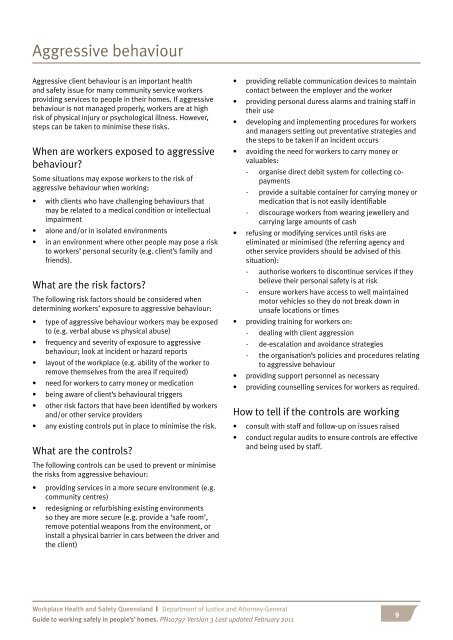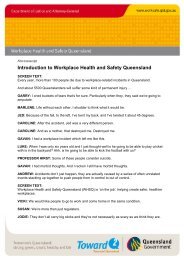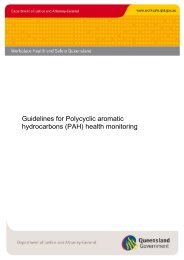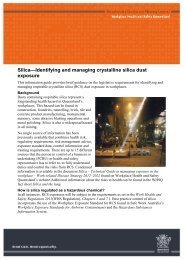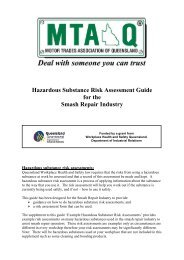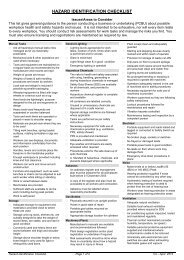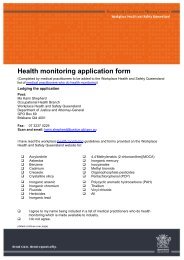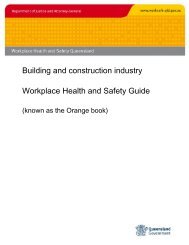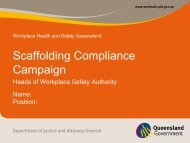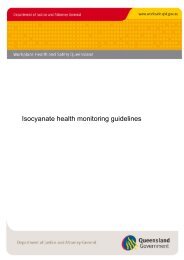Guide to working safely in people's homes - Queensland Government
Guide to working safely in people's homes - Queensland Government
Guide to working safely in people's homes - Queensland Government
Create successful ePaper yourself
Turn your PDF publications into a flip-book with our unique Google optimized e-Paper software.
Aggressive behaviour<br />
Aggressive client behaviour is an important health<br />
and safety issue for many community service workers<br />
provid<strong>in</strong>g services <strong>to</strong> people <strong>in</strong> their <strong>homes</strong>. If aggressive<br />
behaviour is not managed properly, workers are at high<br />
risk of physical <strong>in</strong>jury or psychological illness. However,<br />
steps can be taken <strong>to</strong> m<strong>in</strong>imise these risks.<br />
When are workers exposed <strong>to</strong> aggressive<br />
behaviour?<br />
Some situations may expose workers <strong>to</strong> the risk of<br />
aggressive behaviour when <strong>work<strong>in</strong>g</strong>:<br />
• with clients who have challeng<strong>in</strong>g behaviours that<br />
may be related <strong>to</strong> a medical condition or <strong>in</strong>tellectual<br />
impairment<br />
• alone and/or <strong>in</strong> isolated environments<br />
• <strong>in</strong> an environment where other people may pose a risk<br />
<strong>to</strong> workers’ personal security (e.g. client’s family and<br />
friends).<br />
What are the risk fac<strong>to</strong>rs?<br />
The follow<strong>in</strong>g risk fac<strong>to</strong>rs should be considered when<br />
determ<strong>in</strong><strong>in</strong>g workers’ exposure <strong>to</strong> aggressive behaviour:<br />
• type of aggressive behaviour workers may be exposed<br />
<strong>to</strong> (e.g. verbal abuse vs physical abuse)<br />
• frequency and severity of exposure <strong>to</strong> aggressive<br />
behaviour; look at <strong>in</strong>cident or hazard reports<br />
• layout of the workplace (e.g. ability of the worker <strong>to</strong><br />
remove themselves from the area if required)<br />
• need for workers <strong>to</strong> carry money or medication<br />
• be<strong>in</strong>g aware of client’s behavioural triggers<br />
• other risk fac<strong>to</strong>rs that have been identified by workers<br />
and/or other service providers<br />
• any exist<strong>in</strong>g controls put <strong>in</strong> place <strong>to</strong> m<strong>in</strong>imise the risk.<br />
What are the controls?<br />
The follow<strong>in</strong>g controls can be used <strong>to</strong> prevent or m<strong>in</strong>imise<br />
the risks from aggressive behaviour:<br />
• provid<strong>in</strong>g services <strong>in</strong> a more secure environment (e.g.<br />
community centres)<br />
• redesign<strong>in</strong>g or refurbish<strong>in</strong>g exist<strong>in</strong>g environments<br />
so they are more secure (e.g. provide a ‘safe room’,<br />
remove potential weapons from the environment, or<br />
<strong>in</strong>stall a physical barrier <strong>in</strong> cars between the driver and<br />
the client)<br />
Workplace Health and Safety <strong>Queensland</strong> | Department of Justice and At<strong>to</strong>rney-General<br />
<strong>Guide</strong> <strong>to</strong> <strong>work<strong>in</strong>g</strong> <strong>safely</strong> <strong>in</strong> people’s’ <strong>homes</strong>. PN10797 Version 3 Last updated February 2011<br />
• provid<strong>in</strong>g reliable communication devices <strong>to</strong> ma<strong>in</strong>ta<strong>in</strong><br />
contact between the employer and the worker<br />
• provid<strong>in</strong>g personal duress alarms and tra<strong>in</strong><strong>in</strong>g staff <strong>in</strong><br />
their use<br />
• develop<strong>in</strong>g and implement<strong>in</strong>g procedures for workers<br />
and managers sett<strong>in</strong>g out preventative strategies and<br />
the steps <strong>to</strong> be taken if an <strong>in</strong>cident occurs<br />
• avoid<strong>in</strong>g the need for workers <strong>to</strong> carry money or<br />
valuables:<br />
- organise direct debit system for collect<strong>in</strong>g copayments<br />
- provide a suitable conta<strong>in</strong>er for carry<strong>in</strong>g money or<br />
medication that is not easily identifiable<br />
- discourage workers from wear<strong>in</strong>g jewellery and<br />
carry<strong>in</strong>g large amounts of cash<br />
• refus<strong>in</strong>g or modify<strong>in</strong>g services until risks are<br />
elim<strong>in</strong>ated or m<strong>in</strong>imised (the referr<strong>in</strong>g agency and<br />
other service providers should be advised of this<br />
situation):<br />
- authorise workers <strong>to</strong> discont<strong>in</strong>ue services if they<br />
believe their personal safety is at risk<br />
- ensure workers have access <strong>to</strong> well ma<strong>in</strong>ta<strong>in</strong>ed<br />
mo<strong>to</strong>r vehicles so they do not break down <strong>in</strong><br />
unsafe locations or times<br />
• provid<strong>in</strong>g tra<strong>in</strong><strong>in</strong>g for workers on:<br />
- deal<strong>in</strong>g with client aggression<br />
- de-escalation and avoidance strategies<br />
- the organisation’s policies and procedures relat<strong>in</strong>g<br />
<strong>to</strong> aggressive behaviour<br />
• provid<strong>in</strong>g support personnel as necessary<br />
• provid<strong>in</strong>g counsell<strong>in</strong>g services for workers as required.<br />
How <strong>to</strong> tell if the controls are <strong>work<strong>in</strong>g</strong><br />
• consult with staff and follow-up on issues raised<br />
• conduct regular audits <strong>to</strong> ensure controls are effective<br />
and be<strong>in</strong>g used by staff.<br />
9


